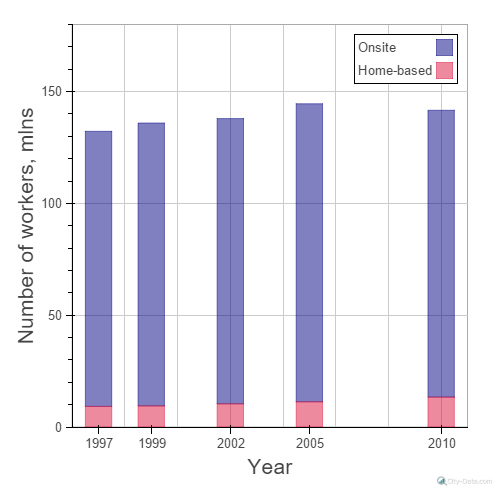Pavel Prikhodko, Ph.D. Machine Learning
Working from home is becoming more and more popular in the U.S. The number of people who prefer to use their own dwelling as a workplace increased slightly in recent years. People who work 9 to 5 may start asking questions like, “Who actually are home-based workers?” and, “Why don’t they fancy a typical job in the office?” There are main types of such workers: home workers, who work exclusively from home, home-based workers, who work from home part or all the time, and mixed workers, who work both from home and from the office.
According to the U.S. Census Bureau, the average American home worker is 47.5 years old, works 37.4 hours per week and has a median salary of about $25,500. The average mixed worker in the United States is 45.5 years old, works 41.4 hours per week and has a median salary of about $52,800.
Business and management are the main occupations where home-based workers are employed most often. Companies based in the western states, particularly California and Washington, are more likely to allow working from home. In 2010, home-based workers made up 24.9 percent of the business, management and financial sectors. The service sector was the second most home-based-friendly category: 16 percent of workers in this sector worked from home. Home-based workers made up 14.6 percent of the sales sector in 2010. About 13.2 percent of education, legal and community service employees were based at home in this year.

The private sector is the most likely to offer a home-based job. If we look at the numbers, 59.5 percent of home-based employees worked in the private sector in 2010.

As you can see, this reflects a rapid increase from 1980, when only 33.6 percent of home-based workers were private-sector employees.
A small number of home-based workers were employed by the government: only 5.6 percent in 2010. The number of people involved in computer and engineering occupations increased by 69 percent, from 252,000 home-based workers in 2000 to 432,000 home-based workers in 2010.
Overall, the number of home-based workers grew by 4.2 million people from 1997 to 2010, mainly due to the technology and communication growth.
These types of jobs often offer less money but provide the possibility of gaining personal freedom. People who choose to work from home obviously enjoy the flexibility of hours and can spend more time with their families. For some people, it’s very important to work with no rigid schedules or bosses to follow. Home-based jobs provide an excellent opportunity for disabled individuals who are unable to work onsite.
Home-based jobs require self-discipline but offer more freedom and opportunities to regulate work-life balance. If your ability to organize yourself and personal freedom are more important than money to you, come and join the army of American home-based workers!
About Pavel Prikhodko
Pavel Prikhodko, Ph.D. Machine Learning
Pavel has worked for many years as a researcher and developer on a wide range of applications (varying from mechanics and manufacturing to social data, finance and advertising), building predictive systems and trying to find stories that data can tell.
In his free time, he enjoys being with his family.
Other posts by Pavel Prikhodko:


